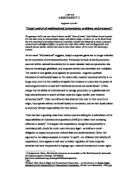Multinational Corporations in context
When we mention MNCs, we instantly concern ourselves with firms such as McDonalds, Coca-cola and Nike. However, there are plenty more of these firms in the international market, which are also known as TNCs. Some are often puzzled by the ultimate definition which is still facing small-scale controversy, ‘enterprise operating in several countries via assets or production facilities where the firm has 25% or more of its output capacity located outside its country of origin’. It often occurs that several of these MNCs’ budgets are so great that they exceed the GDP of several countries. The world's largest multinational in 2000, was Exxon Mobil which has a value greater than the GDP of Pakistan whilst the joint revenues of the four largest MNCs outweighed the combined gross national product of all African countries. The budgets raised by MNCs across the world are so great that they influence many newly industrialized and less economically developed countries. In a highly competitive world, companies seek to reduce their costs as much as possible and therefore the prospect of a foreign company setting up in a country where labour is cheap is attractive for both the company and the host country's government. These influences can be both good and bad but what are the specific motives for MNCs existing and are there any particular examples?
The financial sector is a dominant and rather large industry in the global market despite it’s recent collapse in several MEDCs it still plays a massive role within the lives of consumers and businesses. China boasts a bank that is not only the largest and most reputed within the country but also the world’s 4th largest bank in terms of market capitalization value. On another note BOC London Branch, the first overseas branch of the Chinese banks, was established in 1929 and from then on the firm has spread to several other regions. It is prominently recognised as the oldest bank in the People’s Republic of China and currently operates in over 27 countries. Despite its presence in these countries, the bank’s operations outside of China accounted for less than 4% whilst mainland China was responsible for 68% of its fortunes. The bank benefits from fairly low recruitment costs however these are rising due to the Economic growth of China (therefore average wages are rising) as well as the increasing popularity of the bank’s image. This can be accounted from the dominant manufacturers and wholesalers in China who are under great demand from many countries in addition to MNCs, due to cheaper costs of production. As a result more firms are paying Chinese based businesses via the BOC payment method and the bank is consequently gaining higher commissions. High end investment from several other leading firms such as RBS and Halifax have furthermore provided the bank with support and vital funds. The development of China as an international superpower has only harnessed Bank of China’s ultimate objectives of attaining a significant market share of Asia’s financial market and then formidably, the number one bank in the world.








